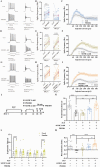Allosteric Modulation of the Sigma-1 Receptor Elicits Antipsychotic-like Effects
- PMID: 34865170
- PMCID: PMC8886599
- DOI: 10.1093/schbul/sbab137
Allosteric Modulation of the Sigma-1 Receptor Elicits Antipsychotic-like Effects
Abstract
Allosteric modulation represents an important approach in drug discovery because of its advantages in safety and selectivity. SOMCL-668 is the first selective and potent sigma-1 receptor allosteric modulator, discovered in our laboratory. The present work investigates the potential therapeutic effects of SOMCL-668 on phencyclidine (PCP)-induced schizophrenia-related behavior in mice and further elucidates underlying mechanisms for its antipsychotic-like effects. SOMCL-668 not only attenuated acute PCP-induced hyperactivity and PPI disruption, but also ameliorated social deficits and cognitive impairment induced by chronic PCP treatment. Pretreatment with the selective sigma-1 receptor antagonist BD1047 blocked the effects of SOMCL-668, indicating sigma-1 receptor-mediated responses. This was confirmed using sigma-1 receptor knockout mice, in which SOMCL-668 failed to ameliorate PPI disruption and hyperactivity induced by acute PCP and social deficits and cognitive impairment induced by chronic PCP treatment. Additionally, in vitro SOMCL-668 exerted positive modulation of sigma-1 receptor agonist-induced intrinsic plasticity in brain slices recorded by patch-clamp. Furthermore, in vivo lower dose of SOMCL-668 exerted positive modulation of improvement in social deficits and cognitive impairment induced by the selective sigma-1 agonist PRE084. Also, SOMCL-668 reversed chronic PCP-induced down-regulation in expression of frontal cortical p-AKT/AKT, p-CREB/CREB and BDNF in wide-type but not sigma-1 knockout mice. Moreover, administration of the PI3K/AKT inhibitor LY294002 abolished amelioration by SOMCL-668 of chronic PCP-induced schizophrenia-related behaviors by inhibition of BDNF expression. The present data provide initial, proof-of-concept evidence that allosteric modulation of the sigma-1 receptor may be a novel approach for the treatment of psychotic illness.
Keywords: AKT–CREB–BDNF pathway; SOMCL-668; allosteric modulator; chaperone protein; schizophrenia.
© The Author(s) 2021. Published by Oxford University Press on behalf of the Maryland Psychiatric Research Center. All rights reserved. For permissions, please email: journals.permissions@oup.com.
Figures




Similar articles
-
Allosteric Modulation of Sigma-1 Receptors Elicits Rapid Antidepressant Activity.CNS Neurosci Ther. 2016 May;22(5):368-77. doi: 10.1111/cns.12502. Epub 2016 Feb 8. CNS Neurosci Ther. 2016. PMID: 26854125 Free PMC article.
-
Allosteric modulation of sigma-1 receptors elicits anti-seizure activities.Br J Pharmacol. 2015 Aug;172(16):4052-65. doi: 10.1111/bph.13195. Epub 2015 Jun 26. Br J Pharmacol. 2015. PMID: 25989224 Free PMC article.
-
Phencyclidine-induced cognitive deficits in mice are improved by subsequent subchronic administration of fluvoxamine: role of sigma-1 receptors.Neuropsychopharmacology. 2007 Mar;32(3):514-21. doi: 10.1038/sj.npp.1301047. Epub 2006 Feb 22. Neuropsychopharmacology. 2007. PMID: 16495935
-
Delineating biochemical and functional properties of sigma receptors: emerging concepts.Crit Rev Neurobiol. 1993;7(3-4):187-203. Crit Rev Neurobiol. 1993. PMID: 8106175 Review.
-
[Sigma receptors: the key to therapeutic action or the side-effects of neuroleptics?].Psychiatr Pol. 1992 Sep-Oct;26(5):365-72. Psychiatr Pol. 1992. PMID: 1363828 Review. Polish.
Cited by
-
Mechanism of Efferocytosis in Determining Ischaemic Stroke Resolution-Diving into Microglia/Macrophage Functions and Therapeutic Modality.Mol Neurobiol. 2024 Oct;61(10):7583-7602. doi: 10.1007/s12035-024-04060-4. Epub 2024 Feb 27. Mol Neurobiol. 2024. PMID: 38409642 Review.
-
Exploring the Association between Schizophrenia and Cardiovascular Diseases: Insights into the Role of Sigma 1 Receptor.Physiol Res. 2023 Jul 31;72(Suppl 2):S113-S126. doi: 10.33549/physiolres.935099. Physiol Res. 2023. PMID: 37565416 Free PMC article. Review.
-
Sigma-1 Receptor Activation by Fluvoxamine Ameliorates ER Stress, Synaptic Dysfunction and Behavioral Deficits in a Ketamine Model of Schizophrenia.J Neuroimmune Pharmacol. 2025 Jul 25;20(1):76. doi: 10.1007/s11481-025-10231-4. J Neuroimmune Pharmacol. 2025. PMID: 40711497 Free PMC article.
-
Selective recognition memory impairment in mitochondrial hydroxylase Clk1 mutant mice, rescued by antipsychotics.Acta Pharmacol Sin. 2025 Sep 1. doi: 10.1038/s41401-025-01641-4. Online ahead of print. Acta Pharmacol Sin. 2025. PMID: 40890445
-
The Missing Piece? A Case for Microglia's Prominent Role in the Therapeutic Action of Anesthetics, Ketamine, and Psychedelics.Neurochem Res. 2023 Apr;48(4):1129-1166. doi: 10.1007/s11064-022-03772-0. Epub 2022 Nov 3. Neurochem Res. 2023. PMID: 36327017 Review.

